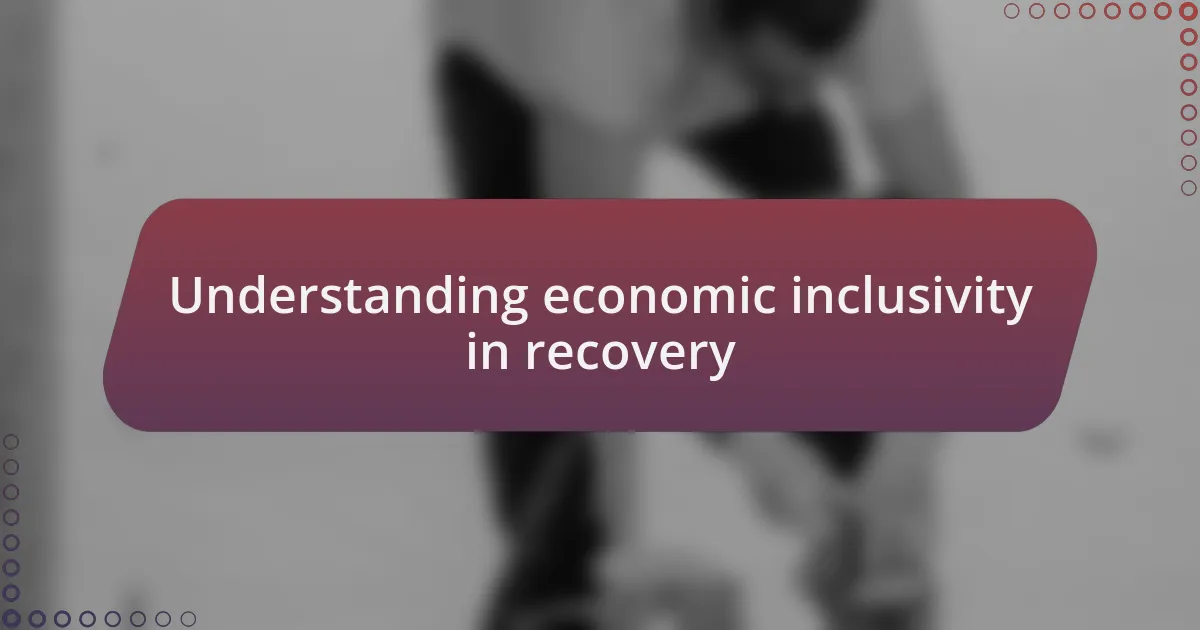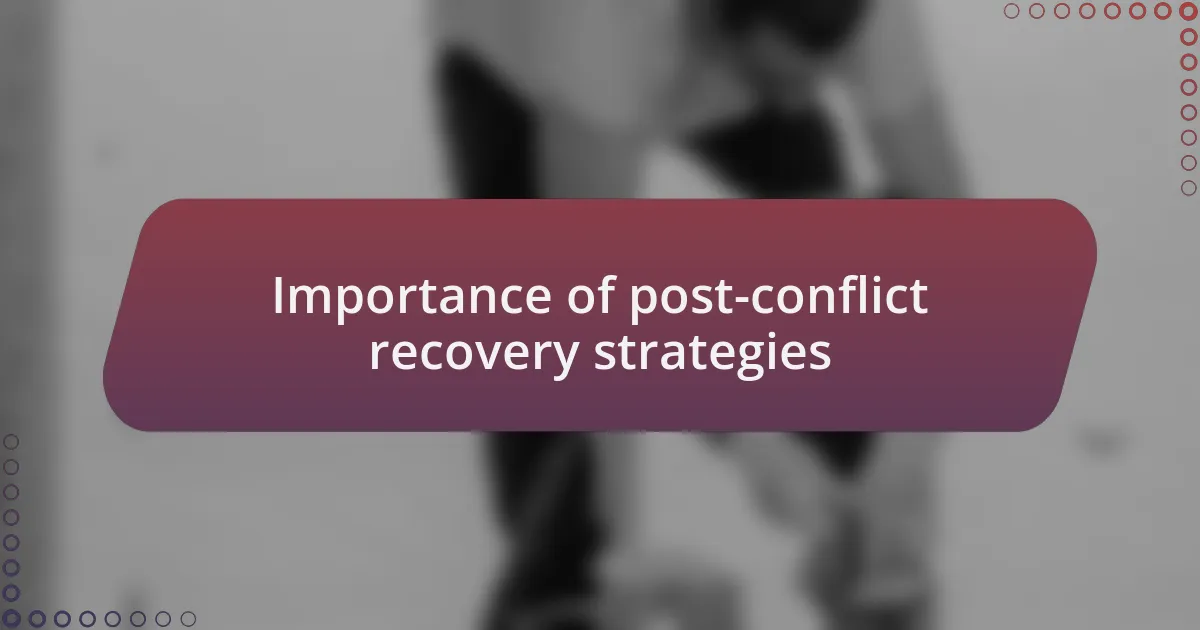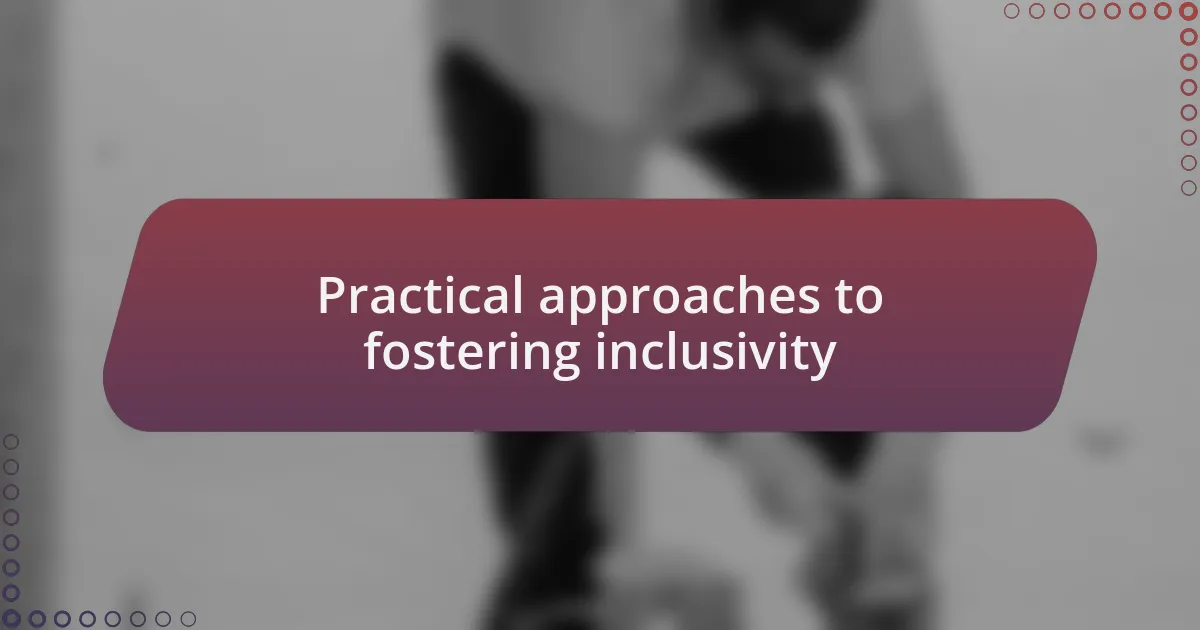Key takeaways:
- Economic inclusivity in recovery is vital for rebuilding lives and fostering community resilience through local entrepreneurship and collaboration.
- In post-conflict recovery, active participation from all community members, especially marginalized groups like women, is essential for sustainable progress.
- Key challenges include discrimination, lack of financial resources, and inadequate infrastructure, which hinder economic opportunities in affected communities.
- Successful initiatives involve community engagement, tailored financial programs, and measuring success through personal stories rather than just economic metrics.

Understanding economic inclusivity in recovery
Economic inclusivity in recovery is about more than just rebuilding infrastructure; it’s about rebuilding lives and communities in a way that everyone can participate. From my experience, I’ve seen how encouraging local entrepreneurship can spark hope in communities. When individuals have the opportunity to start their businesses, it not only empowers them but also restores a sense of identity and belonging.
Consider the emotional weight of starting a new venture after conflict. I recall working alongside a group of women who, despite their traumatic pasts, banded together to launch a cooperative. Their determination was infectious, illustrating that economic inclusivity isn’t just an abstract concept; it’s the key to healing. How can we encourage more such initiatives? It’s essential to ask ourselves what barriers exist and how we can remove them.
Understanding economic inclusivity means recognizing that diverse perspectives strengthen recovery efforts. I’ve often thought about how different voices bring unique solutions to the table—solutions that resonate with various community needs. By actively engaging everyone in the recovery process, we foster resilience and sustainability, proving that inclusivity is not merely beneficial but a vital component of lasting peace.

Importance of post-conflict recovery strategies
Post-conflict recovery strategies play a crucial role in rebuilding not just economies, but also relationships and trust within communities. I remember visiting a village that was devastated by conflict; the palpable sense of despair among the residents was heartbreaking. When we introduced recovery strategies that emphasized collaboration and shared goals, I witnessed communities slowly coming together, fostering a renewed hope and sense of belonging.
During these recovery efforts, we’ve learned that sustainable progress hinges on active participation from all community members. I’ve seen firsthand how women, often the unsung heroes in post-conflict scenarios, lead initiatives that uplift entire households. What if we didn’t just view these strategies as necessities, but as opportunities for transformation and healing? The potential for growth when diverse voices are included is immense, and it’s a powerful reminder of the strength inherent in community-driven recovery.
Ultimately, effective post-conflict recovery strategies pave the way for long-term stability and peace. As I reflect on my experiences, I realize the strategies we implement today can shape the futures of generations to come. Ensuring that every individual has a seat at the table isn’t merely an ideal; it’s an essential step toward a united, prosperous society. How can we continue to advocate for these strategies to thrive? The answer lies in our commitment to inclusivity and genuine engagement in the recovery process.

Key challenges in economic inclusivity
One of the key challenges in achieving economic inclusivity is the pervasive issue of discrimination. I’ve observed how biased attitudes can shape economic opportunities in post-conflict settings. For instance, in a project I participated in, several talented individuals from marginalized communities faced barriers simply because of their backgrounds, often overshadowing their skills and potential. How often do we overlook the capabilities of those deemed ‘less worthy’?
Another significant hurdle is the lack of access to financial resources. During my work in a war-torn region, I encountered countless entrepreneurs who possessed brilliant ideas but lacked the capital to bring them to life. It was disheartening to see passion stifled by economic limitations. If only we redirected our focus toward creating inclusive financial systems, how much innovation could we unlock?
Finally, inadequate infrastructure poses a tremendous challenge for economic inclusivity. Reflecting on a community development program, I witnessed firsthand how insufficient transport and communication networks hindered businesses from flourishing. It made me think: what good are great products if there’s no way to reach customers? Investing in infrastructure isn’t just about building roads; it’s about building pathways to opportunity for everyone.

Practical approaches to fostering inclusivity
One practical approach to fostering inclusivity is establishing community-led initiatives that promote collaboration among diverse groups. I once participated in a local workshop where members from various backgrounds came together to share resources and knowledge. This not only broke down existing barriers but also sparked creativity as people realized they could learn something unique from one another. Could you imagine the innovation that could arise when everyone feels empowered to contribute?
Another effective strategy involves tailoring financial programs to meet the specific needs of marginalized populations. During a project aimed at supporting female entrepreneurs, I saw how offering micro-loans and mentorship specifically designed for women changed lives. Those women transformed their businesses and, in turn, their communities. How can we ensure that financial services are truly accessible and responsive to those who have been historically sidelined?
Skill-building workshops focused on local market demands are also essential. I remember organizing training sessions for young adults transitioning from conflict to civilian life, where we emphasized practical skills that matched local economic opportunities. The enthusiasm was palpable; they finally saw a direct pathway to contributing meaningfully to their communities. Isn’t it time we prioritize these kinds of programs that resonate with real community needs?

Community engagement in economic recovery
When engaging communities in economic recovery, fostering a sense of ownership is crucial. I recall a project where community members were invited to lead discussions on what economic initiatives would benefit them. Watching their eyes light up as they proposed ideas made me realize that when people feel their voices matter, they’re more likely to invest in the outcomes. Isn’t it fascinating how a little empowerment can ignite a collective drive for progress?
Building networks is another vital aspect of community engagement in economic recovery. I joined forces with local artisans who were struggling to find markets for their handmade goods. By connecting them with local businesses, we created a vibrant marketplace that benefited everyone involved. The joy on their faces when they saw their products appreciated by the community was incredibly rewarding. How often do we overlook the power of collaboration in boosting local economies?
Participating in community meetings can also serve as a unique barometer for economic recovery efforts. I remember attending a gathering where residents shared their economic anxieties and aspirations. This open dialogue not only provided critical insights for policymakers but also nurtured a shared vision for recovery. Can you imagine the possibilities if everyone had a seat at the table? It’s truly inspiring to see how community engagement transforms not just individual lives, but the entire fabric of society.

My personal strategies for inclusivity
When it comes to promoting inclusivity, I believe in actively listening to diverse voices within the community. In one instance, I hosted a series of informal coffee chats where individuals from various backgrounds shared their experiences. The stories they told, filled with both struggles and triumphs, opened my eyes to perspectives I hadn’t considered before. How often do we miss out on incredible insights simply because we don’t take the time to listen?
Another approach I cherish is creating opportunities for skill-sharing workshops. I organized a session where locals could teach one another valuable skills—like sewing, carpentry, or even digital literacy. Witnessing a grandmother passing down her crafting techniques to a young single mom was heartwarming. It’s moments like these that remind me how inclusivity enriches not just individual lives, but the entire community fabric. Isn’t it amazing how sharing knowledge can foster connections and build resilience?
Lastly, I prioritize ensuring that economic initiatives are accessible to everyone by intentionally designing programs with inclusivity at their core. For example, I once developed a microfinance project tailored for women entrepreneurs, who often face unique barriers. The sheer determination I saw in their faces was a powerful motivator for me. What if every economic policy considered everyone’s unique needs? The potential for transformative impact is staggering.

Measuring success in economic initiatives
Measuring the success of economic initiatives goes beyond just looking at numbers. I recall a project I executed that focused on job creation; while we celebrated the number of new roles established, what truly mattered was the feedback from those who filled them. When a middle-aged man expressed how he finally felt dignified through work after years of unemployment, it was clear that success had many dimensions.
Another critical aspect I found was the importance of community engagement in assessing outcomes. During a program aimed at boosting local businesses, we conducted follow-up surveys—not merely to tally profits, but to capture personal stories and changes in life quality. I remember one vendor sharing that her income allowed her to send her kids to school, which highlighted how our project transcended economic metrics to touch lives.
Lastly, I believe in the value of collaborative evaluations, where stakeholders come together to discuss successes and failures openly. This reminds me of a roundtable we held after finishing a workforce development initiative. As participants shared their insights, it became clear that the true measure of success was not only economic growth but the strengthened community ties and renewed hope that emerged. How often do we consider these human elements in our evaluations? They can turn numbers into stories, and stories foster deeper connections.